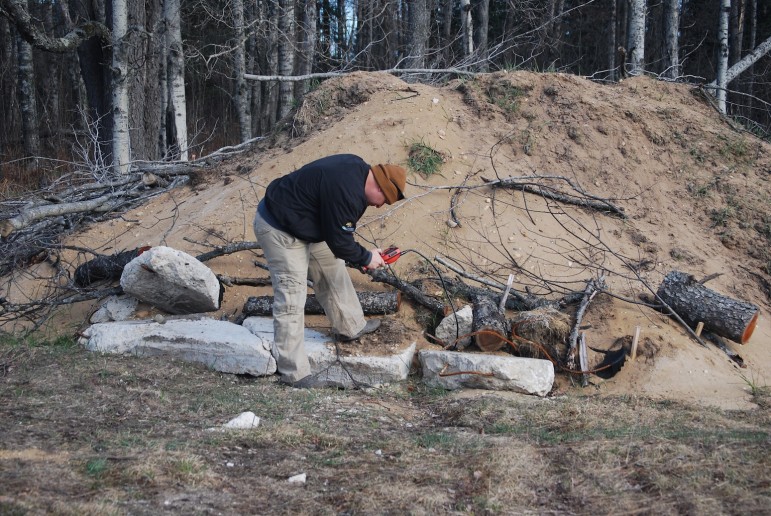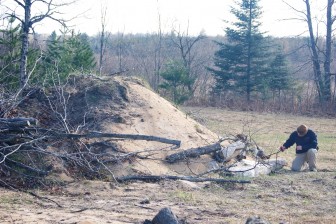By KEVIN DUFFY
Capital News Service
LANSING – Conservation biologists have built the first artificial home for snakes in Northern Michigan.
And they removed an entire dam to do it.
Experts say the snakes need the help.

A restoration specialist uses a videoscope to detect snakes. Credit: Herpetological Resource and Management
Native snakes, including the Eastern Mississauga rattlesnake and Northern water snake, require shelter from cold winters. But development threatens their habitat in what is “the greatest impact to amphibian and reptile populations and reproduction,” said David Mifsud, a wetlands ecologist at Herpetological Resource and Management (HRM) who helped with the project.
To meet their needs, biologists create homes for snakes out of existing restoration projects. That’s what recently happened on the North Branch of the Manistee River near Kalkaska.
The Conservation Resource Alliance, a Traverse City-based nonprofit organization that helps groups collaborate on such work, restored nearly 150 miles of the river’s habitat. The project restored trout passage and the adjacent riverbank.
And biologists threw in an underground snake refuge as an unexpected bonus.
In 2008, the alliance restored the 1,720-acre Flowing Well Trout Farm after the state bought it. All hatchery buildings were demolished to return the property to its natural state.
The former hatchery near Kalkaska was shut after officials identified a whirling disease infestation in the trout it raised. The disease stems from a parasite that inflicts neurological damage in salmon and trout, causing their spines to harden. The fish can’t escape predators because they are forced to swim in a circular motion.

A team member monitors a hibernaculum. Credit: Herpetological Resource and Management
By 2013, the alliance and its partners had removed a dozen 8-foot dams and five undersized culverts on the Upper Manistee River. That let fish swim through the newly connected floodplains.
Until then, the Mecum Road crossing over the North Branch of the Manistee was considered the “worst remaining stream crossing on the North Branch of the Manistee,” said fisheries biologist Mark Tonello of the Department of Natural Resources (DNR).
Dam removal and culvert construction left behind concrete on the site. Instead of hauling it away, workers used it to restore snake habitat, said Chris Pierce of the conservation alliance.
There was precedent for the move: The U.S. Fish and Wildlife Service and the Natural Resources Conservation Service had done something similar in Wisconsin a couple of years earlier. Biologists in Michigan copied that effort and made what is technically known as a snake hibernaculum.
Hibernacula are natural or synthetic structures used by dormant or hibernating species. They include existing burrows, caves, sinkholes, dikes and bridge foundations – anything that offers stable temperatures.
When temperatures reach extremes, snakes seek refuge. As poikilotherms – cold-blooded animals whose body temperature fluctuates – snakes escape the cold by basking in the sunlight and escape the heat by burrowing underground.
HRM, a Chelsea-based firm, and former alliance biologist Eric Ellis identified this opportunity for habitat improvement.
The conservation alliance built the hibernaculum following a snake model that has documented several species that use it, including the Eastern hog-nosed snake. HRM continues to monitor the presence and distribution of reptiles, amphibians and aquatic macro-invertebrates.
In 2011, a 14-foot pit was dug to keep the hibernaculum below the frost line so it wouldn’t freeze in the winter. Workers then transported excess concrete from the dam removal to the new site.
The move also made financial sense.
The hibernaculum cost less than $2,000, but it would have cost “up to three times more to haul the concrete offsite,” said biologist Kim Balke, the Betsie River project manager for Conservation Resource Alliance. Balke recently oversaw completion of a similar hibernacula in the Benzie County part of the Betsie River watershed.
Large rocks and 3-foot concrete pieces were placed at the bottom of the pit to create natural openings where snakes can hide. Smaller rubble and natural debris were layered over large concrete pieces to fill larger gaps.
The structure was then concealed with a geotextile “filter” fabric and several feet of dirt, giving snakes several points of entry.
Species inhabiting the North Branch of the Manistee are sensitive to environmental factors such as pollutants and act as bioindicators – species used to monitor environmental health, according to the DNR.
Pierce said the Conservation Resource Alliance created the artificial hibernaculum to promote ecosystem growth and offset damage from development. The habitat adjacent to the Manistee provides a regional wildlife refuge buffered by thousands of acres of state-owned land.
Natural hibernacula created by other native species can be a “limiting resource,” Mifsud said. Design of these structures generally targets a specific species, but the North Branch of the Manistee is home to many species requiring safe living spaces.
Critical microhabitats, like hibernacula, are often “unintentionally destroyed due to ignorance of what they are and their value to wildlife,” he said.
Removal of dams and construction of microhabitats improve land
degraded by mismanagement.
Support from the Fish and Wildlife Service and funding from existing partnerships allowed the Conservation Resource Alliance to complete the Flowing Well Dam Removal Project.
Kevin Duffy writes for Great Lakes Echo.